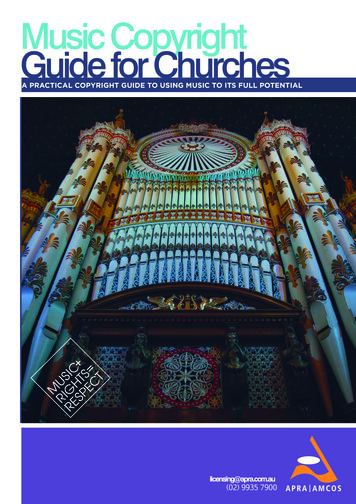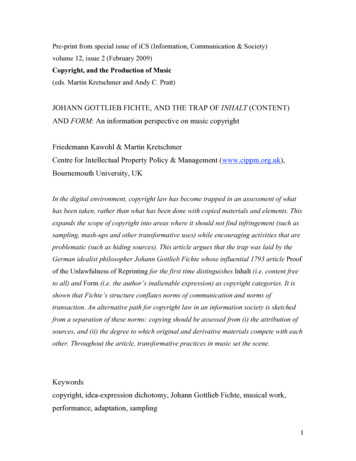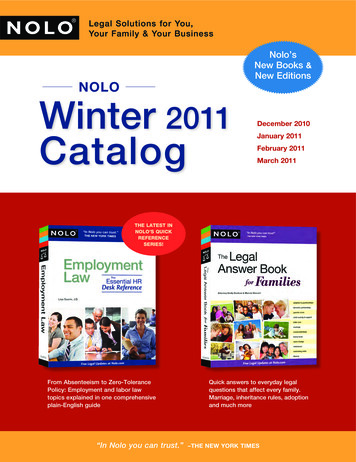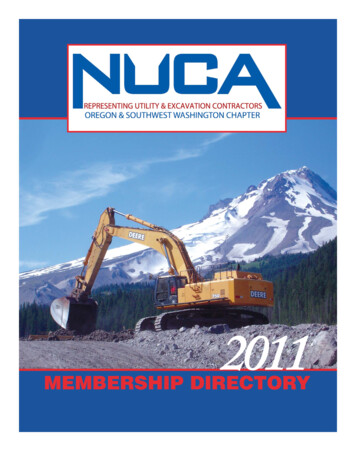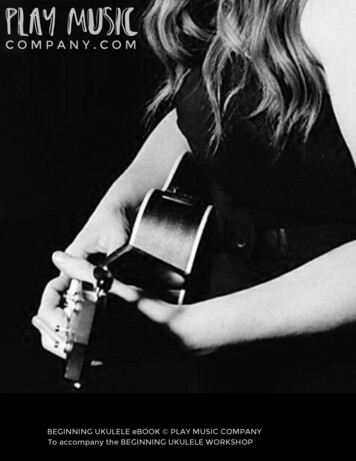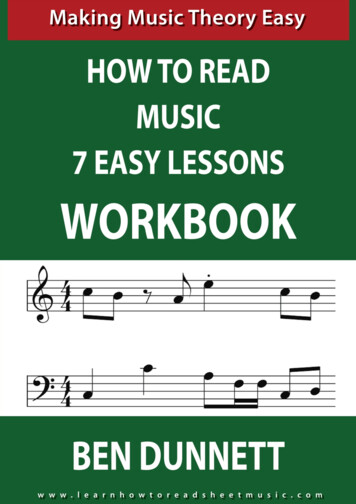
Transcription
Sheet Music Workbook!copyright 2011 Benjamin Dunnett
LE A R N HOW TO READ SHEET MUSI CI N 7 LESSONSWORKBOOKWelcome to the Sheet Music Workbook.This workbook uses a unique combination of worksheets and practical activities designedto enable you to be able to read sheet music quickly and effectively. It should becompleted alongside the “How to Read Sheet Music in 7 easy Lessons” course. Theworksheets can be printed off and completed whenever you want. The answers for eachworksheet are found in the back of the workbook so you can check you progress.The practical activities are designed so that you can start to try to play sheet music on yourinstrument straight away. This is the revolutionary principle of this course.putting yourtheoretical understanding into practical playing straight away.My advice is to read a lesson and reflect upon it. Then, test your understanding using theworksheets and try the the practical exercises/pieces on your instrument. Remember, thecombination of theory and practical is the key to success.When you have completed the course there is “The Big Test” for you to sit, together witha certificate of completion.Good luck!Benjamin Dunne!Sheet Music Workbook!copyright 2011 Benjamin Dunnett
CO NTENTSWORKSHEETS!5Lesson One Worksheets!6Lesson One Practical Task!9Lesson Two Worksheet!10Lesson Two Practical Task!11Lesson Three Worksheet!12Lesson Three Practical Task!13Lesson Four Worksheet!14Lesson Five Worksheet!15Lesson Six Worksheet (Practical)!16Lesson Seven Worksheet!17WORKSHEET ANSWERS!18Lesson One Worksheet Answers!19Lesson Two Worksheet Answers!22Lesson Three Worksheet Answers!23Lesson Four Worksheet Answers!24Lesson Five Worksheet Answers!25Lesson Seven Worksheet Answers!26Sheet Music Workbook!copyright 2011 Benjamin Dunnett
THE BIG TEST!27THE BIG TEST ANSWERS!33How Did You Do?!39Certificate Of Completion!39LIMIT OF LIABILITY/DISCLAIMER OF WARRANTYThe author makes no representations or warranties with respect to the accuracy orcompleteness of the contents of this work and specifically disclaim all warranties, includingwithout limitation warranties of fitness for a particular purpose. No warranty may be createdor extended by sales or promotional materials. The advice and strategies contained herein maynot be suitable for every situation. This work is sold with the understanding that the publisheris not engaged in rendering legal, accounting, or other professional services. If professionalassistance is required, the services of a competent professional person should be sought.Neither the publisher nor the author shall be liable for damages arising herefrom. Pleaseunderstand that there are some links contained in this guide that the author may benefit fromfinancially. The fact that an organization or website is referred to in this work as a citation and/or a potential source of further information does not mean that the author or the publisherendorses the information the organization or website may provide or recommendations it maymake. Further, readers should be aware that internet websites listed in this work may havechanged or disappeared between when the work was written and when it is read. Alltrademarks are the property of their respective owners.C OPYR IG H T N O T I C ENo part of this publication shall be reproduced, transmitted, or sold in whole or in part in anyform, without the prior written consent of the author. All trademarks and registeredtrademarks appearing in this guide are the property of their respective owners.Copyright 2011 Benjamin DunnettPublished by Benjamin DunnettSheet Music Workbook!copyright 2011 Benjamin Dunnett
WOR K S H E E T SSheet Music Workbook!copyright 2011 Benjamin Dunnett
L ES SON ONE WORKSHEETSSheet Music Workbook!copyright 2011 Benjamin Dunnett
Sheet Music Workbook!copyright 2011 Benjamin Dunnett
Sheet Music Workbook!copyright 2011 Benjamin Dunnett
LE SSON ON E PRACTICAL TASKYO U R F I R S T T U N E SHave a go at playing these 3 pieces on your instrument.There is a line under each note if you find it helpful to write the note names in.Sheet Music Workbook!copyright 2011 Benjamin Dunnett
L ESSON T WO WORKSHEETT E MP O A N D T IM E S IG N AT U R E SWhat do the following tempo markings mean:Total score:1. Adagio.2. Allegro.3. Andante./10How would you write the following tempi (tempi plural of tempo)4. Quite Quick .5. Very Fast.How many beats in a bar in the following time signatures:6.!6!8.7.!!24.What type of beats are they in the following time signatures:8.!!22.9.!!1216.What does the following marking mean:10. 60bpm.Sheet Music Workbook!copyright 2011 Benjamin Dunnett
LE S SON T WO PRACTICAL TASKP L AY W I TH A S ENS E OF P U LS EHave a go at playing these tunes. Similarly to the Lesson 1 Practical task, the note lengthsare all the same, but this time try to emphasize the 1st beat of every bar by playing it a bitlouder than the others.In this extract emphasize beats 1 and 4Sheet Music Workbook!copyright 2011 Benjamin Dunnett
L E S SON T H REE WORKSHEETN O T E D U R AT I ONTotal score:Q.s. 1-5. Fill in the missing note values:/10NOTENOTESYMBOLLENGTH1 beatHow many beats is each of the following notes worth:!6. .!7. .!8. .!9. .How many beats is the following worth:10. .Sheet Music Workbook!copyright 2011 Benjamin Dunnett
L ES SON T H R E E PRACTICAL TASKP U L SE AN D D U R AT I ONThis is a difficult task because you need to try to put together your understanding of pulse(Lesson 2) with duration (Lesson 3). Try to keep a clear sense of pulse in your head asyou play. Donʼt worry if you find this difficult - see it as preparation work for the materialwe will be covering in Lesson 4. Good luck!!Sheet Music Workbook!copyright 2011 Benjamin Dunnett
L ESSON F OUR WORKSHEETR H Y T HM S A ND R ES T SSheet Music Workbook!copyright 2011 Benjamin Dunnett
L ES SON F IVE WORKSHEETDY N A M I C STotal score:What do the following dynamic markings mean:1. Forte.2. pp.3. mp./10How would you write the following dynamics:4. Very loud .5. Quiet.What do the following abbreviations mean:6. cresc.7. dim.What do the following signs tell you to do:8. .9 .10. .Sheet Music Workbook!copyright 2011 Benjamin Dunnett
LESSON SI X WORKSHEET(P RACTICAL)HA R M ONYHave a go at playing these chord patterns on your instrument. You will find they really helpyour fingers get used to playing chords.Sheet Music Workbook!copyright 2011 Benjamin Dunnett
L ES SON SEVEN WORKSHEETD I R E C T ION STotal score:(2 marks per Q.)What do the following directions mean:/101. da capo.2. dal segno.3. What does this sign mean?.4. What does this sign mean?.5. How many bars should be played in total in this passage?.Sheet Music Workbook!copyright 2011 Benjamin Dunnett
WO R K S H E E TA NSW E R SSheet Music Workbook!copyright 2011 Benjamin Dunnett
LE S S O N ON E WORKSHEET ANSWERS1 . T R E B LE C LE F N OT E SSheet Music Workbook!copyright 2011 Benjamin Dunnett
LE S S O N ON E WORKSHEET ANSWERS2 . B A SS C LEF N OT E SSheet Music Workbook!copyright 2011 Benjamin Dunnett
LE S S O N ONE WORKSHEET ANSWER S3 . L E D G ER LI NE SSheet Music Workbook!copyright 2011 Benjamin Dunnett
L ES S O N T WO WORKSHEET ANSWER ST E MP O A N D T IM E S IG N AT U R E SWhat do the following tempo markings mean:1. AdagioSlow2. AllegroFast3. AndanteWalking PaceHow would you write the following tempi (tempi plural of tempo)4. Quite Quick moderato5. Very FastprestissimoHow many beats in a bar in the following time signatures:6.!6!867.!!242What type of beats are they in the following time signatures:8.!!22minims9.!!1216semiquaversWhat does the following marking mean?10. 60bpm60 quavers in a minuteSheet Music Workbook!copyright 2011 Benjamin Dunnett
L E SSON TH REE WORKSHEETANSWERSN O T E D U R AT I ONQ.s. 1-5. Fill in the missing note values:NOTENOTESYMBOLLENGTH4 beats2 beats1 beat½ beat¼ beat⅛ beatHow many beats is each of the following notes worth:!6. 3 beats!!7. 1½ beats !8. ⅜ beat!9. 6 beats.How many beats is the following worth:Sheet Music Workbook!copyright 2011 Benjamin Dunnett
10.6 beatsL ESSON FOUR WORKSHEETANSWERSR H Y T HM S A ND R ES T SSheet Music Workbook!copyright 2011 Benjamin Dunnett
LES S O N F I V E WORKSHEET ANSWERSDY N A M I C SWhat do the following dynamic markings mean:1. ForteLoud2. ppVery Quiet3. mpQuite QuietHow would you write the following dynamics:4. Very loudFortissimo5. QuietPianoWhat do the following abbreviations mean:6. cresc.Gradually get louder7. dim.Gradually get quieterWhat do the following signs tell you to do:8. Play a note suddenly with force9 Sudden emphasis on a note10. Lean on a noteSheet Music Workbook!copyright 2011 Benjamin Dunnett
L ESSON SEVEN WORKSHEETANSWERSD I R E C T ION SWhat do the following directions mean:1. da capoGo back to the start of the piece2. dal segnoGo back to the sign3. What does this sign mean?Go back to the start (or a start repeat mark)4. What does this sign mean?Loop previous material5. How many bars should be played in total in this passage?7 bars in totalSheet Music Workbook!copyright 2011 Benjamin Dunnett
TH E B I G T E S TSheet Music Workbook!copyright 2011 Benjamin Dunnett
T H E BIG TESTPrint out the following testTry to complete the test in 35 minutes. ! !!!!TOTAL MARKS: 50Questions 1-16Sheet Music Workbook!copyright 2011 Benjamin Dunnett
What do the following tempo markings mean?17. Presto ! .18. Moderato19. Adagio.How would you write the following tempi?20. Fast !.How many beats in a bar in the following time signatures?21.!!128.22.!!64.What type of beats are they in the following time signatures?23.!!24.24.!!1232.25. What does the following marking mean? 120bpm!Sheet Music Workbook!.copyright 2011 Benjamin Dunnett
Q.s. 26-29. Fill in the missing note values:NOTENOTESYMBOLLENGTHHow many beats is each of the following notes worth?!30. .!31. . !32. .! !!33. .Questions 34-37.Sheet Music Workbook!copyright 2011 Benjamin Dunnett
What do the following dynamic markings mean?38. Piano!.39. f!.40. mf !.41. How would you write the following dynamic?Very quiet .42. What does the following abbreviation mean?cresc.43. What does the following sign tell you to do?!!.44. What does the following direction mean?dal segno.45.What does this sign mean?!!.Sheet Music Workbook!copyright 2011 Benjamin Dunnett
46.What is the dot called under the 1st note below?.!48.!47. What does the dot tell the performer to do? .! What are these curved lines called?.49. !What is this line above the note called?.50. What type of note is this?.51. !What is this called?.TOTAL MARKS: 50Sheet Music Workbook!copyright 2011 Benjamin Dunnett
TH E B I G T E S TA NSW E R SSheet Music Workbook!copyright 2011 Benjamin Dunnett
TH E B I G TEST ANSWERSQuestions 1-16Sheet Music Workbook!copyright 2011 Benjamin Dunnett
What do the following tempo markings mean?17. Presto ! Very fast18. Moderato19. AdagioQuite fastSlowHow would you write the following tempi?20. Fast !AllegroHow many beats in a bar in the following time signatures?21.!!128!!1222.!!64!!6What type of beats are they in the following time s25. What does the following marking mean? 120bpm!Sheet Music Workbook!120 quavers in a minutecopyright 2011 Benjamin Dunnett
Q.s. 26-29. Fill in the missing note values:NOTENOTESYMBOLLENGTH42halfan eighthHow many beats is each of the following notes worth?30. 1 and a half!31. 3 beats !32. 3 beats!!!33. 3 eighthsQuestions 34-37.Sheet Music Workbook!copyright 2011 Benjamin Dunnett
What do the following dynamic markings mean?38. Piano!Quiet39. fLoud!40. mf !Quite loud41. How would you write the following dynamic?Very quiet ! pianissimo42. What does the following abbreviation mean?cresc.get louder43. What does the following sign tell you to do?!!accent the note by playing it louder44. What does the following direction mean?dal segnogo back to the sign45.What does this sign mean?!!!Sheet Music Workbook!repeatcopyright 2011 Benjamin Dunnett
46.What is the dot called under the 1st note below?!!!detached)48.47. What does the dot tell the performer to do? shorten the note (or play! What are these curved lines called?!49. !staccatoslurs (not ties)What is this li
worksheets can be printed off and completed whenever you want. The answers for each worksheet are found in the back of the workbook so you can check you progress. The practical activities are designed so that you can start to try to play sheet music on your instrument straight away. This is the revolutionary principle of this course.putting your theoretical understanding into practical .


